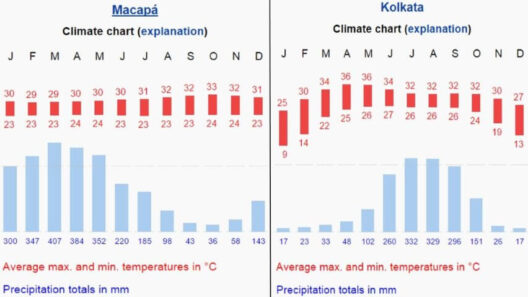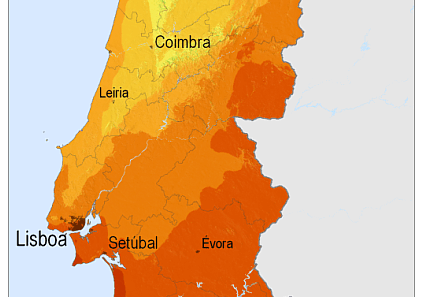Earth’s climate is a complex system influenced by a multitude of variables. Among these, three primary factors emerge that dramatically shape the climate we experience: solar radiation, atmospheric composition, and ocean currents. Each of these components plays a pivotal role in determining temperature, precipitation patterns, and overall climatic conditions. To understand these factors better is to grasp the essence of climate science and the delicate balance of our planet’s ecosystems.
Solar radiation is perhaps the most fundamental factor influencing Earth’s climate. The sun provides the energy required to sustain life and drive weather systems. Variations in solar output, albeit subtle, can trigger significant shifts in climate. Historical data has shown periods of heightened solar activity, known as solar maxima, correlate with warmer climatic phases. Conversely, sunspot cycles and lower solar radiation during solar minima may coincide with cooler periods, often referred to as little ice ages.
Moreover, the Earth’s axial tilt and orbit around the sun, known as Milankovitch cycles, play a critical role in the distribution of solar energy received at different latitudes. These variations affect not only seasonal temperature fluctuations but also glacial and interglacial periods over millennia. Understanding these cycles helps us comprehend why regions experience prolonged warmth or cold phases and the longer-term climatic shifts that accompany them.
However, solar radiation alone does not dictate weather patterns and climate stability. The atmosphere, with its intricate composition, holds sway over how this energy is absorbed, reflected, and redistributed across the planet. Greenhouse gases such as carbon dioxide, methane, and nitrous oxide are essential in regulating Earth’s temperature. These gases trap heat in the atmosphere, a natural phenomenon known as the greenhouse effect.
Historically, this effect has been vital for maintaining temperatures conducive to life. Nonetheless, anthropogenic activities have significantly altered the concentration of these gases. The combustion of fossil fuels, deforestation, and industrial processes have led to unprecedented rises in greenhouse gas levels, intensifying the greenhouse effect. As a result, we observe a rapid increase in global temperatures, commonly referred to as global warming. This surge creates a feedback loop, where rising temperatures lead to the melting of polar ice caps, which in turn results in decreased reflectivity of Earth’s surface (known as albedo), further exacerbating warming trends.
The atmospheric composition is not solely about greenhouse gases. Stratospheric and tropospheric influences, such as aerosols and pollutants, significantly affect climate conditions. Aerosols can reflect sunlight, leading to temporary cooling effects, while others may contribute to the formation of clouds and precipitation patterns. Human activity has altered these natural processes, emphasizing the interconnectivity between human actions and climatic outcomes.
The third significant factor influencing Earth’s climate is ocean currents. Oceans cover approximately 71% of the Earth’s surface and serve as a massive heat reservoir. Currents such as the Gulf Stream and the Antarctic Circumpolar Current act like conveyor belts, distributing heat around the globe and moderating temperatures. This circulation impacts not only marine ecosystems but also terrestrial climates.
Changes in ocean currents, often driven by alterations in temperature and salinity due to melting ice and freshwater influxes, can lead to dramatic climatic shifts. The phenomenon known as El Niño, characterized by the periodic warming of surface waters in the central and eastern Pacific Ocean, exemplifies the influence of ocean currents on climate. El Niño events disrupt typical weather patterns, leading to increased rainfall in some regions and droughts in others, showcasing the far-reaching impacts of oceanic systems on global weather.
Additionally, the interplay between ocean currents and atmospheric conditions can have profound implications for climate events such as hurricanes and typhoons. Warmer sea surface temperatures contribute to more intense storms, altering precipitation trends and increasing the frequency of extreme weather events. The ramifications of such changes are myriad: from ecosystem disruptions to socio-economic challenges as communities grapple with the consequences of an unstable climate.
Overarching these factors is the critical observation of how human-induced alterations and natural processes coexist, often resulting in complex feedback loops. While solar radiation remains a constant factor, our greenhouse gas emissions have drastically altered atmospheric conditions and, consequently, oceanic behaviors, pushing Earth’s climate towards unprecedented changes.
In conclusion, solar radiation, atmospheric composition, and ocean currents are the triumvirate of factors that influence the Earth’s climate most dramatically. Their interrelationships paint a picture of a delicate balance, one that humanity must strive to understand and preserve. As climate change continues to reshape our world, recognizing the nuances of these factors is essential for developing effective mitigation and adaptation strategies. Addressing these climatic influencers is not merely an academic pursuit but a necessary endeavor in safeguarding the future of our planet and its inhabitants.







